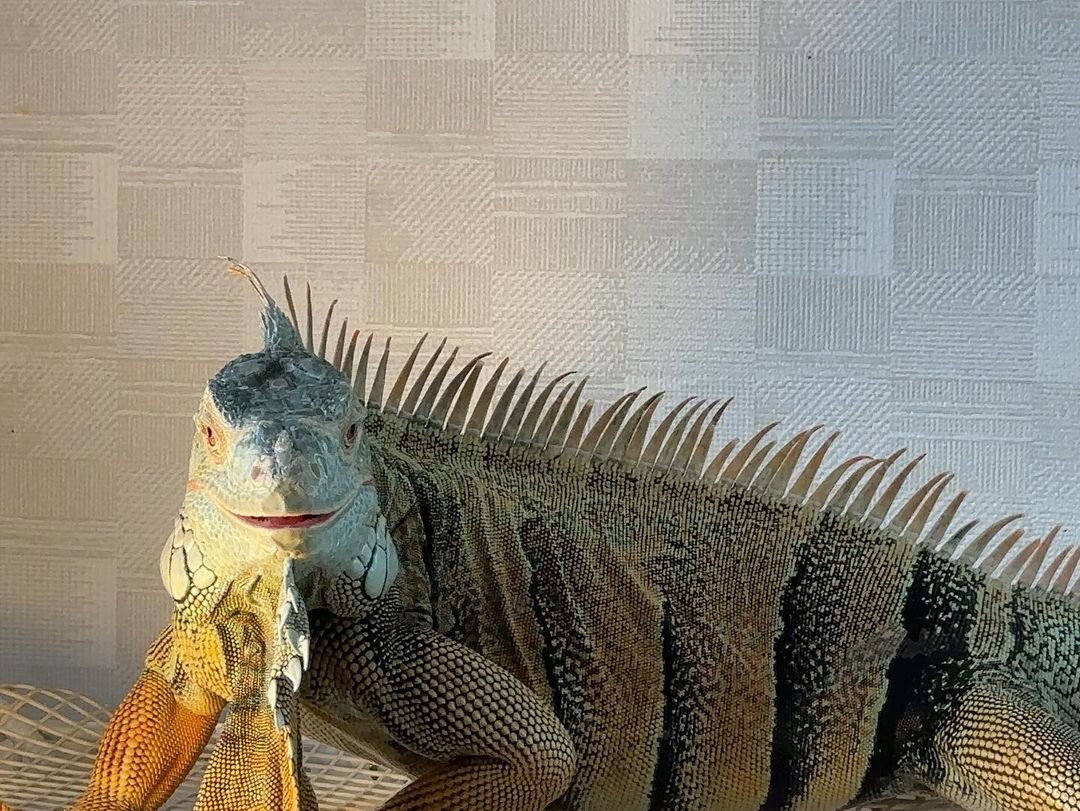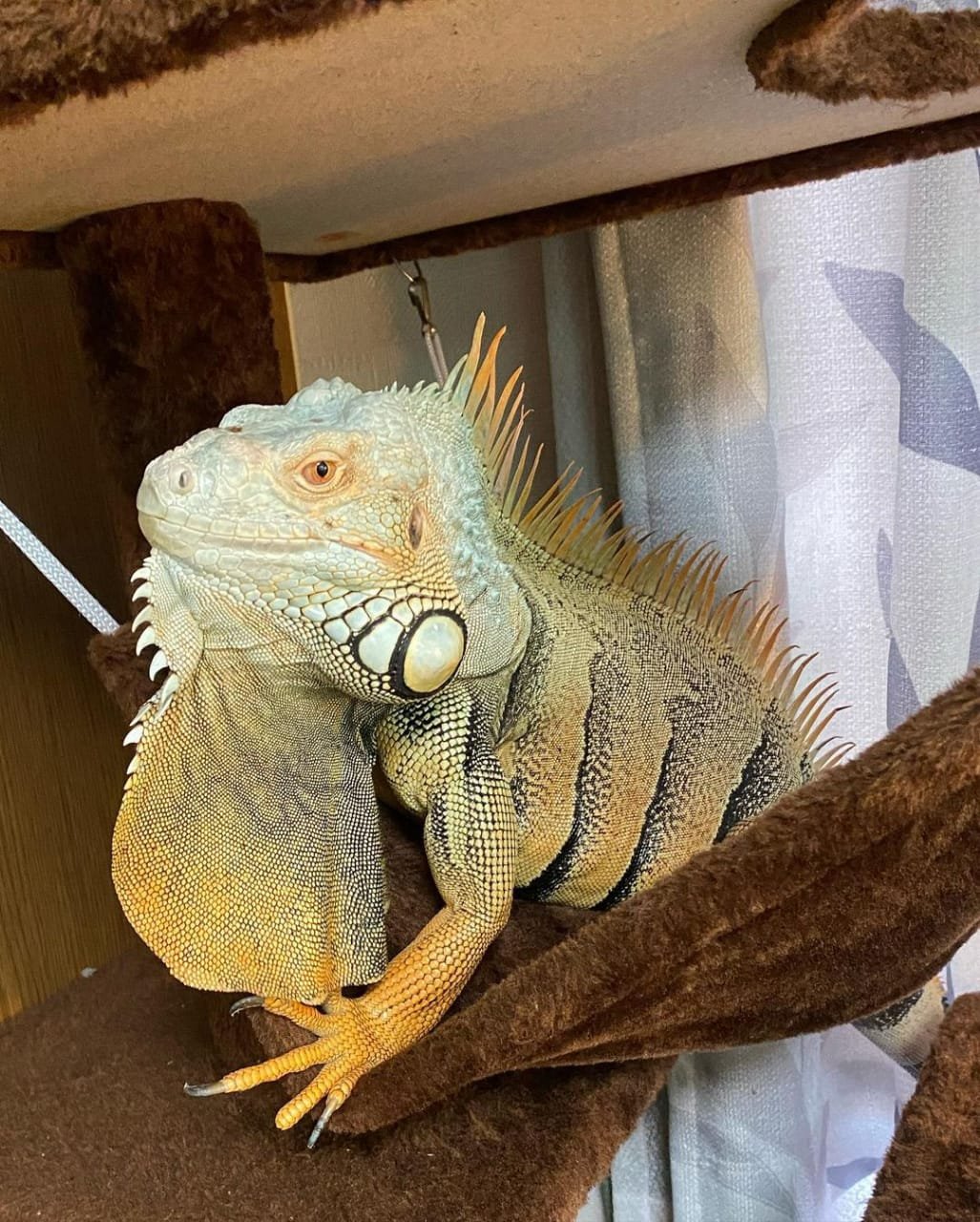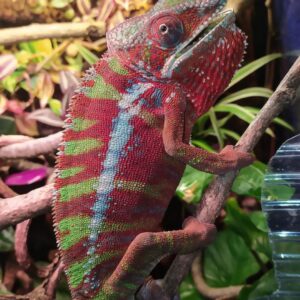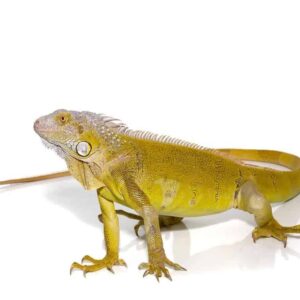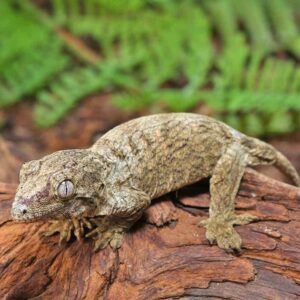Green Iguana For Sale
$450.00
We have a stunning selection of amazing Green Iguanas to be sold from baby iguanas to huge adults (see the drop-down menu to the right). The reptiles that are well-known as tropical are farm-bred, and very healthy.
The Green Iguana have the possibility of becoming long-lived, gentle giants. Their diet is totally vegetarian, meaning that feeding them is easy and affordable. Adults can attain six feet in length. If you purchase a Green Iguana from us, you will automatically be covered by our 100% guarantee of live arrival.
Green Iguana Care Sheet
This care sheet covers all iguanas under the scientific name Iguana iguana, whether they’re actually green, red, yellow, or blue in color.
Green iguanas are giant, semiarboreal, herbivorous lizards with an impressive appearance. They have a large head, round pupils, jowls, large semi-serrated dewlap, strong limbs, long toes, a long muscular tail, and a row of short to long dorsal spines extending from the back of the head to the first third of the tail.
Furthermore,
Color and pattern are highly variable by population. This species is best known for its bright green juvenile coloration, but adults can be gray-green, brown-green, bright green, orange, red, yellow, blue, or a combination of the above. For pattern they may have thin brown banding on the body and/or thin to broad brown or black bands around the tail.
Green iguanas have a wide distribution from Mexico in Central America extending as far south as Paraguay in South America, including many islands in the Gulf of Mexico and Caribbean. They have also been introduced to Florida and Hawaii of the USA, as well as Taiwan, Singapore, and Thailand.
More so,
They do best in hot, humid tropical forest environments.
Male green iguanas are known to reach 6 and even 7′ long (1.8-2.1m). Females are smaller and rarely surpass 5’/1.5m long. Aside from being impressively sized, they are also capable of living 15-20+ years, so expect this pet to become a major part of your life!
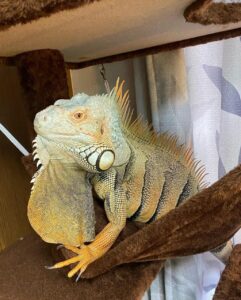
Description
Iguana For Sale Natural Habitat and Distribution
Iguana for sale (Green iguanas), scientifically known as Iguana iguana, are predominantly found in environments that offer a combination of warmth, humidity, and abundant vegetation. These reptiles thrive in tropical rainforests, where the dense canopy provides ample shelter and food sources. The lush, verdant environment of these forests supports their dietary needs, primarily comprising leaves, flowers, and fruit.
In addition to rainforests, green iguanas are commonly found in coastal regions. The mangroves and coastal scrublands offer a perfect habitat with their complex root systems and diverse flora. These coastal areas not only provide plenty of food but also offer safety from predators due to their dense and intricate vegetation structure.
Green iguanas also inhabit riverbanks, which present a unique blend of terrestrial and aquatic environments. The lush vegetation along riverbanks provides food and shelter, while the proximity to water bodies offers a means of escape from predators. These iguanas are excellent swimmers and often dive into the water when threatened, showcasing their adaptability to different habitats.
The geographical distribution of green iguanas spans across Central and South America, including countries such as Mexico, Colombia, Brazil, and Venezuela. They are also prevalent in the Caribbean islands, including Puerto Rico, the Dominican Republic, and the Lesser Antilles. The wide distribution of green iguanas is a testament to their adaptability and resilience in various tropical environments.
Overall, the natural habitats of green iguanas are characterized by warm climates, high humidity, and abundant plant life. These reptiles have successfully adapted to a range of environments, from dense rainforests to coastal regions and riverbanks, across a broad geographical landscape in Central and South America and the Caribbean.
Diet and Feeding Habits
Green iguanas are primarily herbivorous reptiles, a trait that significantly influences their dietary preferences and feeding habits. In their natural habitats, which include tropical rainforests and other lush environments, green iguanas predominantly consume a wide variety of plant matter. Their diet is rich in leafy greens, fruits, and flowers, which provide the necessary nutrients to support their growth and overall health. Commonly consumed plants include dandelion greens, hibiscus flowers, and various types of fruits such as mangoes and papayas.
In captivity, the dietary requirements of green iguanas remain largely similar, although variation in available food options can necessitate some adjustments. Captive iguanas should be offered a balanced diet that mimics their natural consumption patterns as closely as possible. This often includes a mixture of leafy greens like collard greens and mustard greens, along with occasional servings of fruits and vegetables to ensure a well-rounded nutritional intake. It’s crucial to avoid foods high in oxalates or goitrogens, such as spinach and kale, as these can interfere with calcium absorption and thyroid function, respectively.
Proper nutrition is vital for the health and longevity of green iguanas. A diet deficient in essential nutrients can lead to a host of health issues, including metabolic bone disease, renal failure, and gastrointestinal problems. Owners must be diligent in providing a varied and balanced diet, ensuring that their iguanas receive adequate calcium and phosphorus ratios, along with essential vitamins and minerals. Supplementation with calcium powder and multivitamin mixes can be beneficial, especially for young, growing iguanas and those housed indoors without natural sunlight exposure.
By understanding and catering to the dietary needs of green iguanas, both in the wild and in captivity, we can help ensure these fascinating reptiles maintain optimal health and thrive in their respective environments.
Behavior and Social Structure
Green iguanas exhibit a range of intriguing behaviors that are essential for their survival and well-being. One of their most notable habits is basking. These reptiles are ectothermic, meaning they rely on external heat sources to regulate their body temperature. As a result, they can often be found basking in the sun for several hours a day, soaking up the necessary warmth to maintain their metabolic functions.
Territoriality is another significant aspect of green iguanas’ behavior. In the wild, male iguanas are particularly territorial, often establishing and defending areas that provide optimal basking spots and abundant food sources. They use a combination of visual displays and physical confrontations to ward off intruders and assert dominance within their territory.
Social interactions among green iguanas vary depending on their environment. In the wild, they tend to be solitary creatures, coming together primarily during the breeding season. However, in captivity, green iguanas can exhibit varying degrees of social behavior depending on their upbringing and the conditions in which they are kept. Some may tolerate the presence of other iguanas, while others may display aggressive tendencies.
Communication among green iguanas is primarily non-verbal, relying heavily on body language. Head bobbing is a common form of communication, used to signal various intentions and emotions. For example, a rapid series of head bobs can indicate aggression or dominance, while slow, deliberate head bobs might be a form of greeting or acknowledgment. Additionally, they may use dewlap displays, where they extend the flap of skin under their chin to appear larger and more intimidating.
Understanding the behavior and social structure of green iguanas is crucial for both enthusiasts and pet owners. By recognizing and respecting these natural behaviors, one can ensure a healthier and more harmonious environment for these fascinating reptiles.
Reproduction and Lifespan
Green iguanas exhibit unique reproductive behaviors that are essential for the continuation of their species. The mating season for green iguanas typically occurs during the dry season, which varies depending on their geographical location. During this period, male iguanas become particularly territorial and display vivid coloration to attract potential mates. The courtship process involves a series of head bobs and dewlap extensions, which are skin flaps under the chin, to signal their interest to females.
Once mating is successful, the female green iguana will carry the fertilized eggs for approximately two months before seeking a suitable nesting site. She digs a burrow in sandy or soft soil where she can lay a clutch of anywhere from 20 to 70 eggs. After laying the eggs, she covers the nest to protect it from predators and environmental factors. The eggs will incubate for around 90 to 120 days before hatching, depending on temperature and humidity conditions. Upon hatching, the young iguanas are fully independent and receive no parental care.
The lifespan of green iguanas can vary significantly between the wild and captivity. In their natural habitats, green iguanas face numerous threats, including predators, habitat destruction, and limited food resources. These challenges often result in a lifespan of around 10 to 15 years. Conversely, green iguanas in captivity, where they are provided with a controlled environment, regular food supply, and veterinary care, can live much longer, often reaching up to 20 years or more.
Several factors influence the longevity of green iguanas. In captivity, proper diet, adequate UVB lighting, and spacious enclosures are crucial for their health and longevity. Regular veterinary check-ups and prompt treatment of illnesses also play a significant role. In the wild, the availability of food, presence of predators, and environmental conditions all impact their lifespan. Understanding the reproductive cycle and lifespan of green iguanas is essential for their conservation and proper care in captivity.
Challenges and Threats
Green iguanas face a multitude of challenges and threats that significantly impact their survival and well-being. One of the primary threats is habitat destruction. As urbanization and agricultural expansion continue to encroach upon their natural habitats, green iguanas lose crucial nesting and foraging grounds. Deforestation and land conversion for human use result in fragmented habitats, making it difficult for these reptiles to thrive.
Climate change also poses a serious threat to green iguanas. Rising temperatures and altered precipitation patterns can lead to habitat degradation and reduced availability of food sources. Additionally, extreme weather events, such as hurricanes and droughts, can devastate iguana populations, leading to increased mortality rates and disrupted breeding cycles.
The pet trade represents another significant challenge. Green iguanas are often captured from the wild and sold as exotic pets, leading to a decline in their natural populations. The stress of capture, transport, and inadequate care by pet owners can result in high mortality rates. Furthermore, the release of unwanted pet iguanas into the wild can introduce diseases and disrupt local ecosystems.
Invasive species and human activities further exacerbate the threats faced by green iguanas. Predation by non-native animals, such as feral cats and dogs, can reduce iguana numbers. Additionally, human activities like pollution, road construction, and hunting can have detrimental effects on their populations.
To combat these threats, various measures are being implemented to protect green iguanas. Conservation efforts include habitat restoration, legal protection, and public education campaigns to raise awareness about the importance of preserving these reptiles. Captive breeding programs and the regulation of the pet trade are also crucial in ensuring the survival of green iguanas in the wild.
Caring for Green Iguanas as Pets
Green iguanas, with their vibrant color and unique behaviors, can make intriguing pets. However, the commitment to caring for these reptiles is significant and requires a well-prepared environment and a dedicated pet owner. Proper habitat setup is crucial to ensure the well-being of your green iguana. A spacious terrarium, ideally at least 6 feet in length, 6 feet in height, and 3 feet in depth, is necessary to accommodate their size and need for climbing. The enclosure should be equipped with sturdy branches, basking platforms, and UVB lighting to mimic their natural habitat and support their health.
Maintaining the appropriate temperature and humidity levels is essential for green iguanas. The ambient temperature should be kept between 75-85°F during the day, with a basking spot reaching up to 95°F. At night, temperatures can drop to around 70-75°F. Humidity levels should be maintained between 70-80%, which can be achieved through regular misting and the use of humidifiers.
Dietary needs are another critical aspect of green iguana care. These reptiles are primarily herbivorous, requiring a diet rich in leafy greens, vegetables, and occasional fruits. Staple foods include collard greens, mustard greens, and dandelion greens, supplemented with vegetables like squash and bell peppers. Avoid feeding them animal proteins, as these can cause severe health issues. Calcium and vitamin D3 supplements are also necessary to prevent metabolic bone disease.
Regular veterinary check-ups are essential to monitor the health of your green iguana. Common health issues include metabolic bone disease, respiratory infections, and parasites. Observing your iguana’s behavior and physical condition can help detect problems early on. Signs of illness may include lethargy, loss of appetite, and abnormal stool.
Owning a green iguana is a long-term commitment, as they can live up to 20 years with proper care. Potential owners should be prepared for the time, effort, and financial investment required to maintain a healthy and happy green iguana. By understanding and meeting their complex needs, you can ensure a rewarding experience with these fascinating reptiles.


